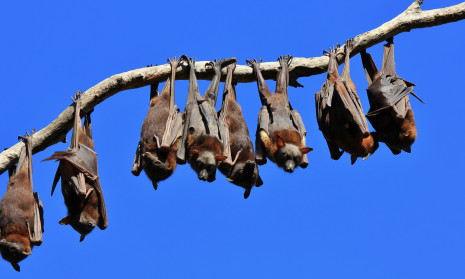Disposal of N waste during water deprivation in birds and bats

Note to readers of this editorial: tropical insectivorous bats are important for insect control! Would any reader who has a knowledge of the mechanisms of bat’s excretion of nitrogen waste or of N metabolism by bats, please comment to the editor of World Agriculture- we should be happy to publish any useful comments under your name.
Water is the most critical nutrient for both plant and animal life- to maintain cellular osmotic pressure, for transport of metabolites and as the medium in which reactions take place. Hence, the increased risk of drought is of great concern in all countries, more particularly those in tropical regions. The sight of water-deprived cattle in drought-stricken tropical countries is quite depressing.
Disposal of N waste
Various species of animal have different mechanisms for conserving their water and retaining turgid cells, whilst disposing of waste products of N metabolism in a water solution. Nitrogenous waste is excreted in three principal forms. These forms include (a) ammonia, (b) urea, and (c) uric acid, by a great variety of animal species.
Excess nitrogenous compounds in the body are very largely and initially converted to ammonia/ammonium ions. Ammonia is highly toxic, but very soluble in water, so its direct excretion is possible only for aquatic animals. Fish excrete 60 % of their nitrogenous waste as this compound and the remainder as trimethylamine oxide. The storage of ammonia in the body poses a risk, so fish deaminate (remove N, the amine group) amino acids in their gills for direct excretion of ammonia.
Urea and uric acid are excreted by terrestrial animals. Urea is highly soluble, but is approximately 100,000 times less toxic than ammonia. Uric acid is a heterocyclic phenolic compound also of very low toxicity, but of low water solubility.
Mammals such as humans convert excess amino acids to urea, while birds, reptiles, and some terrestrial invertebrates produce uric acid as a principal waste of both protein and DNA/RNA breakdown. Moreover, uric acid is the end product of purine metabolism in mammals, during nucleic acid breakdown. The degradation of nucleic acids takes place mainly in the liver and requires an assortment of enzymes to convert them to uric acid. Moreover, a small proportion of the purine, guanine, occurs in avian urine.
Water conservation
Kidneys are the principal route for disposing of N waste products. A major function of this organ is the retrieval of water from waste compounds. Other than mammals, birds are the only vertebrate which conserves body water by producing urine osmotically more concentrated than the blood plasma from which it is derived. Typically, water-deprived birds produce urine that is osmotically 1.4-2.8 times more concentrated than plasma, whereas some mammals can produce urine 20-25 times more concentrated than plasma but, for most mammals, urine is about 5 - 10 times more concentrated. Thus, the concentrating ability of avian kidneys is more limited than in mammals.
This reduced capacity of avian kidneys to concentrate urine (compared to mammals) means that more water accompanies the solutes that travel from the kidneys through ureters to the cloaca. Water-deprived birds do have a mechanism for reducing the amount of water leaving the kidneys.
In response to dehydration, the pituitary gland releases more of a hormone called arginine vasotocin (AVT) into the blood. In the kidneys AVT causes a reduction in the glomerular filtration rate. The extent to which AVT can reduce urine production and water loss varies among species. In general, AVT is less effective in conserving water than the mammalian equivalent (antidiuretic hormone, or ADH, also known as arginine vasopressin, AVP. This hormone is present in most mammals.
However, birds and bats overcome this potential problem by excreting most waste nitrogen, not as a solute, but as a uric acid paste (plus a little guanine) which requires very little water for disposal. It is known as guano, forming the typical white droppings.
This method is used, not only by bats and avian species, but also by diapsids, including most reptiles- i.e. all crocodiles, lizards, snakes, tuatara (reptiles endemic to New Zealand), turtles, and, for that matter, by dinosaurs and invertebrates (insects).
Advantages of uric acid excretion:
1) Uric acid requires only about 0.001 L water per 1 g of N for its excretion. It is the least soluble in water of the three main N wastes (urea in normal human urine is at a concentration of 0.121 L per g N ),
2) it may be stored in cells and body tissues without toxic effects and
3) its low solubility in water means that its storage incurs little additional weight- an important characteristic for animals which fly.
Disadvantages of uric acid excretion
-
Conversion of ammonia into uric acid requires more energy than the conversion of ammonia into urea.
-
Avian urolithiasis, or gout, occurs when kidney function has decreased to the point where uric acid accumulates in the blood and body fluids. The uric acid subsequently precipitates as calcium sodium urate crystals in a variety of locations, particularly in the kidneys and on the serous membranes of the liver, heart, air sacs, and joints.
Tropical species of bats
Whether these bats secrete AVT or AVP has not been determined, to my knowledge, nor has their insensible loss of moisture through the skin been estimated relative to that of birds. So whether they are at a lower or greater risk than are avian species from water deprivation has not been determined.
This importantly depends on their water intake, which is inevitably associated with their differences in diet-e.g. fruit v insects and the differences in their excess intake of protein and nucleic acid.
One must assume that when they are deprived of adequate water they would be at risk of developing urolithiasis, gout – especially insectivorous species of bat!
Download pdf
